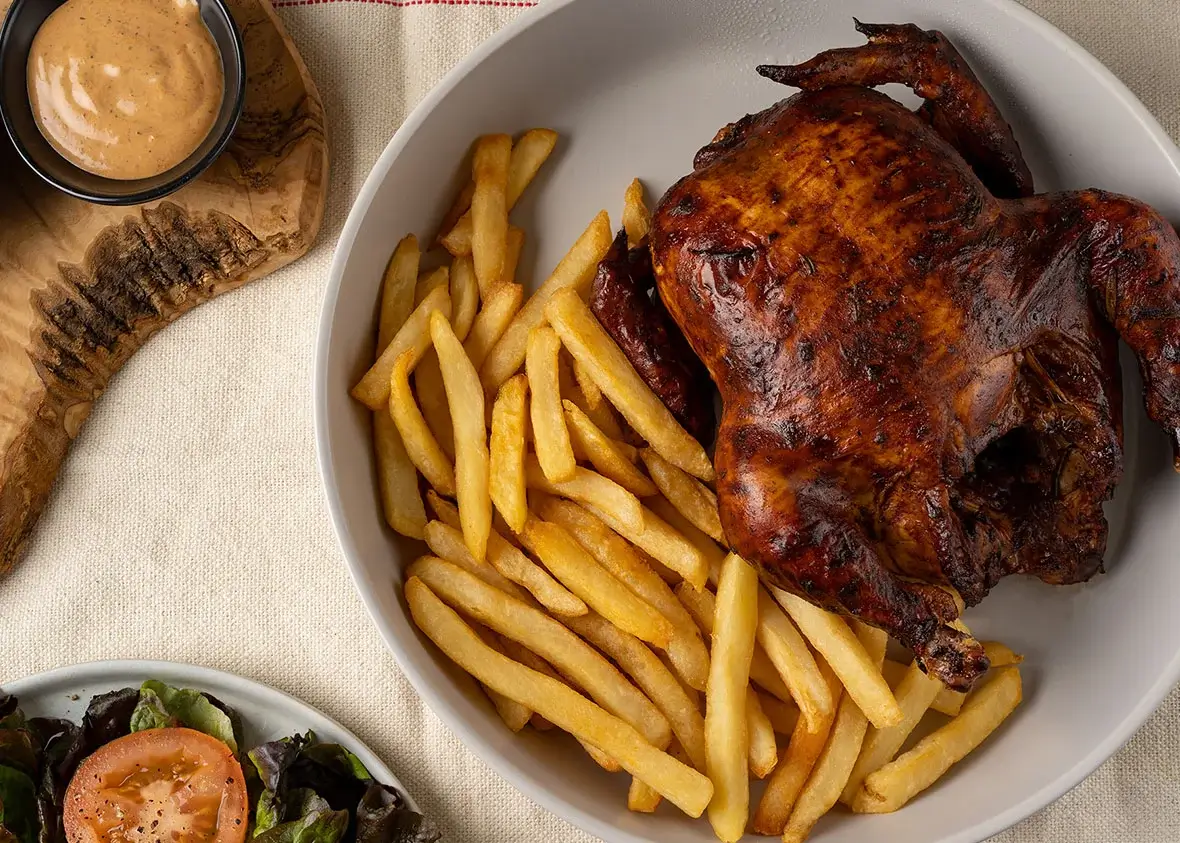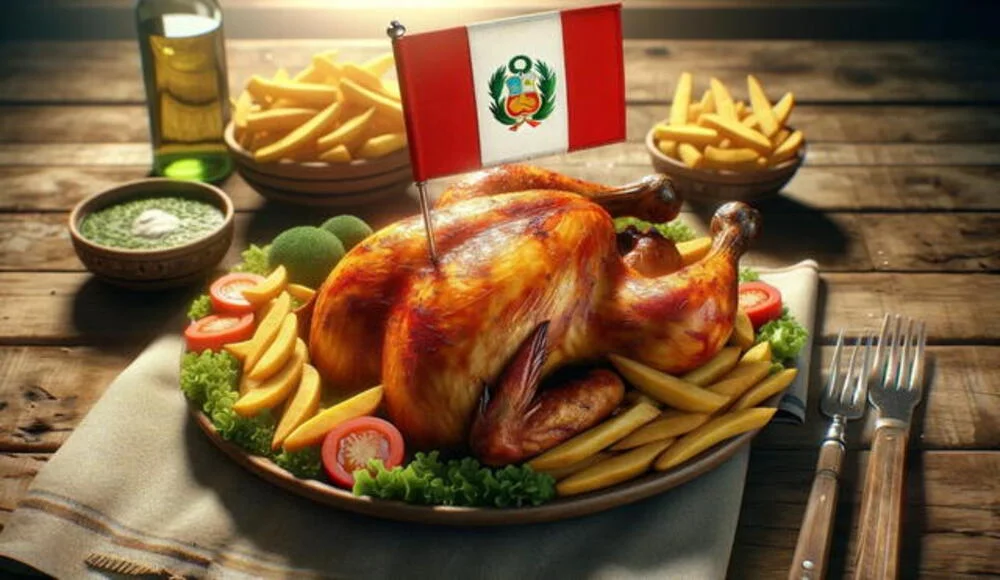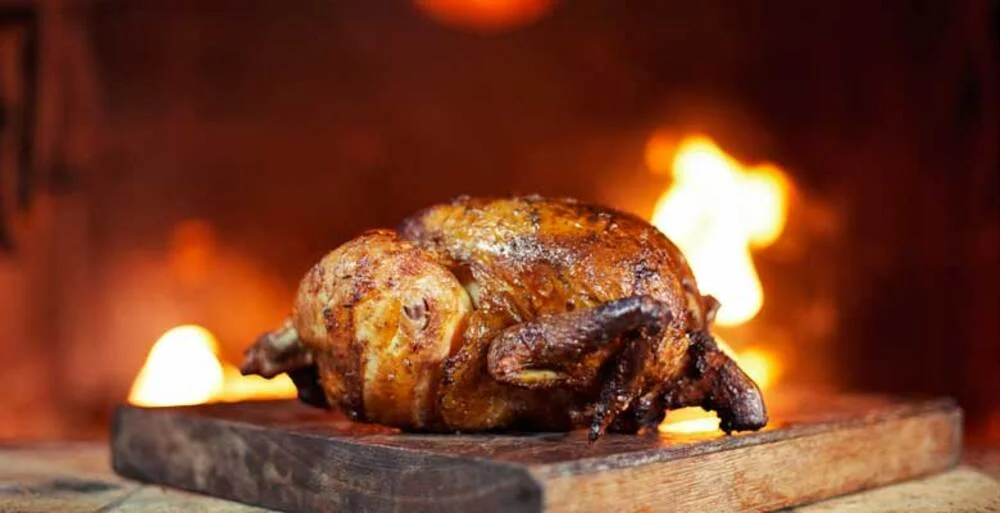When you think of Peruvian cuisine, your mind may wander to ceviche, pisco, or the dazzling colors of Andean markets. But ask any local what their comfort food is, and you’ll hear the same answer again and again: Pollo a la Brasa.
Juicy, crispy, smoky, and packed with flavor this rotisserie-style chicken isn’t just a meal; it’s a beloved ritual that brings families together, fuels travelers after treks, and unites people across Peru’s diverse regions. Whether you’re a foodie, an explorer, or a family adventuring through the Andes, this dish offers a genuine taste of Peruvian daily life.
The Origins of a National Obsession
Pollo a la Brasa literally “chicken cooked over embers” originated in the 1950s when Swiss immigrant Roger Schuler developed a unique rotating spit system to roast chicken evenly over wood coals. What began as a modest restaurant near Lima has evolved into a global phenomenon, with July 21 officially celebrated in Peru as "Día del Pollo a la Brasa."
What Makes It Special?
Unlike typical roasted chicken, Pollo a la Brasa is marinated for hours in a deeply flavorful blend of soy sauce, garlic, black pepper, cumin, paprika, and Peruvian spices, then slowly roasted over wood or charcoal. The result is an irresistible contrast between crisp golden skin and succulent meat, traditionally served with papas fritas (crispy fries), aji sauces, and a fresh salad.
Traveler’s Tip: While every local has their favorite pollería (chicken restaurant), trying more than one is half the fun each offers a unique spin on seasoning, cooking time, or sauces.
Key Facts:
- Origin: Invented in 1950 in Chaclacayo, Peru, by Roger Schuler, a Swiss immigrant.
- Cooking Method: Traditionally cooked in a rotisserie oven called “El Rotombo”, developed by engineer Franz Ulrich.
- Popularity: Consumed more often than ceviche in Peru—on average, 37 times per person per year.
- Accompaniments: Typically served with crispy french fries, a simple side salad, and a variety of house-made sauces like ají de pollería, rocoto, and mayonnaise-based dips.
- National Day: Celebrated on the third Sunday of July as Día del Pollo a la Brasa.
Where to Eat Pollo a la Brasa in Peru
Whether you’re trekking the Inca Trail, relaxing in Lima, or exploring the Sacred Valley, you’re never far from a top-tier pollería. Here are some favorite stops along the way:
1. Lima: The Capital of Pollerías
- Pardos Chicken: A modern take with high-quality ingredients and sleek ambiance.
- Don Tito: A local favorite known for its smoky flavor and generous portions.
- Primos Chicken Bar: Ideal for travelers looking for gourmet-style Pollo a la Brasa with craft cocktails.
2. Cusco: Fuel for the Adventurous
- La Granja Real: A hidden gem just outside the historic center.
- Pollería Los Toldos: Affordable, authentic, and always packed with locals.
3. Sacred Valley & Beyond
- El Mesón de Don Tomás (Pisac): Combines mountain views with traditional recipes.
- Pollos Dani (Ollantaytambo): A great local experience post-Machu Picchu exploration.
Pro Tip for Families: Most pollerías are family-friendly and offer combo meals, making them perfect stops between excursions.
The Cultural Significance: More Than Just Chicken
In Peru, eating Pollo a la Brasa is a social event you’ll see families sharing big platters, coworkers enjoying after-hours dinners, and travelers bonding over condiments and crispy fries. It’s a reminder that food in Peru is not only about flavor it’s about connection, celebration, and comfort.
“The best meals are shared,” says Peruvian People. “And nothing brings people together like a whole chicken on the table.”
How Peruvians Really Eat Pollo a la Brasa: Rituals, Sides & Sauces
Pollo a la Brasa isn’t just something you order it’s a whole experience. In Peru, eating this dish is almost ceremonial. It’s what you do on a Sunday with the family, after school with friends, or on a lazy night when cooking feels like too much. It’s that reliable, flavorful constant in everyday Peruvian life.
Here’s how locals really enjoy it:
1. The Classic Combo
Always served as a combo plate, a typical order includes:
- Crispy papas fritas (french fries), often piled high
- Fresh lettuce and tomato salad, usually with a squeeze of lime
- Ají sauces each table has at least two: ají amarillo (mild and tangy) and rocoto (spicy and bold)
- A cold Inca Kola or chicha morada (purple corn drink) to wash it down
2. Sharing is a Must
In Peru, chicken is rarely ordered solo. You go in on a medio pollo (half chicken) or a pollo entero (whole chicken) to share. It’s served pre-cut so everyone can dive in no awkward carving needed.
3. Sauce Loyalty Runs Deep
Ask a Peruvian which ají is best, and prepare for a passionate answer. Some swear by the creamy yellow ají pollero, others chase the heat of rocoto. Some even mix them both. There’s no wrong choice just strong preferences.
4. No Forks? No Problem
It’s totally normal to dig in with your hands. The skin is too crispy and the meat too juicy to waste time with utensils. Napkins are essential and plentiful.
At-Home Cooking Tips:
While replicating the charcoal rotisserie flavor at home is tough without specialized equipment, you can still make a delicious version using a regular oven. Marinate the chicken overnight and bake it at 350°F (180°C) for about 90 minutes, ideally in a vertical position for even browning. For enhanced flavor, consider using Huacatay, Pisco, or Achiote if available.
Pollo a la Brasa and Your Peruvian Adventure
At Andean Travel Experience, we believe that food is a window into the soul of a country. Including a stop at a traditional pollería is a delicious way to enhance your itinerary, whether you’re crossing the Altiplano or sailing on Lake Titicaca.
Custom Culinary Add-Ons for Travelers
- Private guided food tours in Lima and Cusco
- Cooking experiences with local chefs in the Sacred Valley
- Family-friendly culinary adventures
- Custom foodie itineraries for gourmets and culture lovers
Interested in adding culinary stops to your trip? Contact us today or DM us on Instagram to start planning.
FAQs About Pollo a la Brasa
Is Pollo a la Brasa spicy?
Not inherently. The marinade focuses on depth and umami. For heat, try the ají amarillo or rocoto sauces on the side.
Can I find Pollo a la Brasa outside Peru?
Yes! It’s made its way to the U.S., Europe, and beyond. But to taste the real thing, made with Peruvian wood and tradition? Peru is the place.
Is Pollo a la Brasa suitable for kids?
Absolutely. Kids love the crispy skin and fries just watch the sauce!
Is Pollo a la Brasa gluten-free?
Often, yes but it depends on the marinade and sides. Traditional recipes use natural ingredients, but always check if soy sauce (which may contain gluten) is used.
Is Pollo a la Brasa healthy?
It can be! It’s high in protein and typically roasted rather than fried. Choose salad over fries and go easy on the sauces if you're watching calories
When do Peruvians eat Pollo a la Brasa?
It’s a national favorite perfect for Sunday lunch with family, celebrations, or even a quick weeknight dinner. There’s even a national day for it in July!
What is the meaning of Pollo a la Brasa?
Pollo a la Brasa means “rotisserie chicken” in Spanish, but in Peru, it’s so much more. It refers to a whole chicken marinated in a signature blend of spices, then roasted over charcoal or wood in a special rotisserie oven. It’s a beloved national dish and a symbol of Peruvian comfort food.
Why is Pollo a la Brasa so good?
Because it hits all the right notes:
- Juicy meat, crispy skin
- A deeply flavorful marinade (garlic, cumin, soy sauce, and more)
- Slow-roasted over wood or charcoal for a smoky, irresistible finish
Add the spicy ají sauces and golden fries, and you’ve got the perfect bite.
Is Pollo a la Brasa healthy?
It can be a balanced option. Since it’s roasted not fried it’s lower in fat than many fast foods. It’s rich in protein, and you can pair it with salad or veggies. Just keep an eye on portion sizes and sauces if you're watching your intake.
What is medio pollo a la brasa?
Literally “half a rotisserie chicken.” It's a standard portion in many Peruvian restaurants, usually served with fries, salad, and a side of ají sauce. Perfect for one hungry traveler or to share with someone else alongside other dishes.
Pollo a la Brasa is more than a dish. It’s the aroma of sizzling coals on a street corner in Lima. It’s the comfort after a long hike in the Andes. It’s Peru’s way of saying: Welcome, sit down, eat, and stay a while.
Whether you’re on your first journey or your fifth, don’t miss this unforgettable flavor during your Peru Tour.



